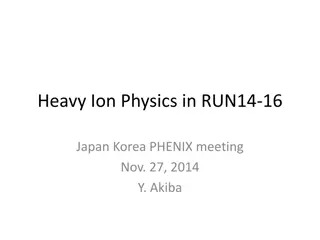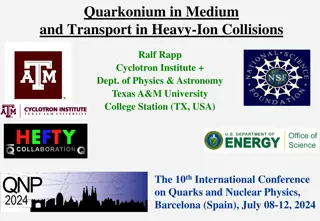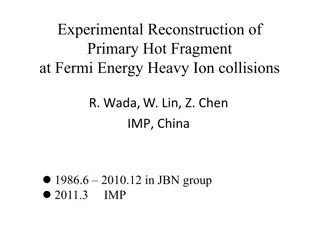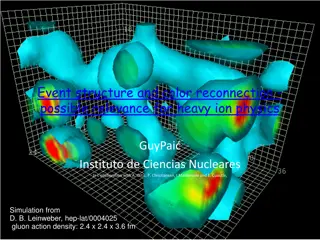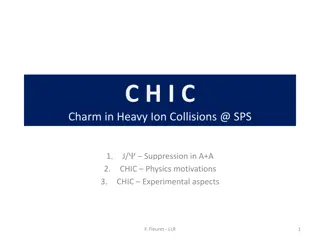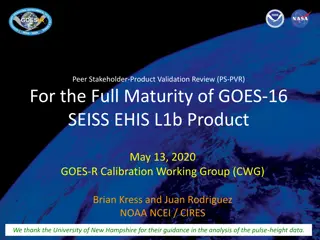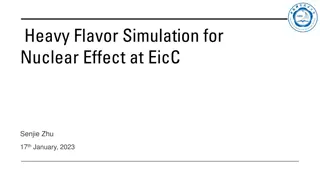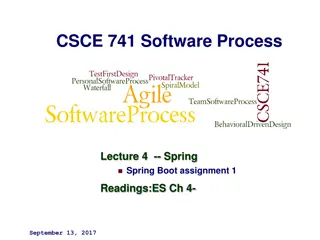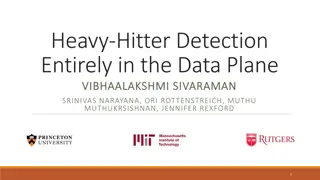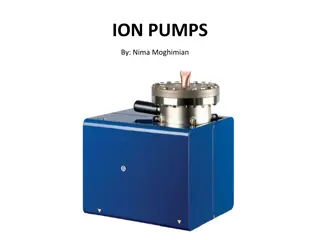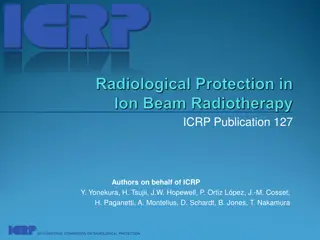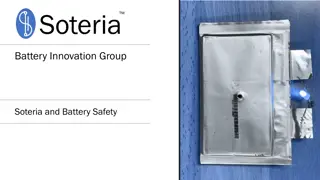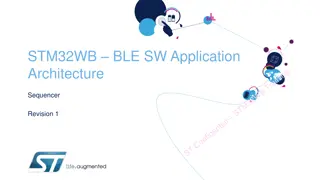Project Task for Heavy Ion Physics Class at Mt. Csand Etvs University 2023/24 Spring Semester
This project involves analyzing real data from ultrarelativistic heavy ion collisions to measure physical observables such as elliptic flow (v2) or HBT radii (R) versus pT and centrality. It includes working with ROOT format data, setting up C++ and ROOT environments, installing necessary tools, and utilizing an analysis package for data evaluation. The goal is to gain insights into heavy ion physics through practical applications and research tasks.
Download Presentation

Please find below an Image/Link to download the presentation.
The content on the website is provided AS IS for your information and personal use only. It may not be sold, licensed, or shared on other websites without obtaining consent from the author. Download presentation by click this link. If you encounter any issues during the download, it is possible that the publisher has removed the file from their server.
E N D
Presentation Transcript
PROJECT TASK FOR HEAVY ION PHYSICS CLASS M t Csan d E tv s University 2023/24 spring semester
Basic info, goals and tools You will start working with real (simplified) data from ultrarelativistic heavy ion collisions Data means: list of events in ROOT format Event means: global event information (centrality, etc) + list of reconstructed tracks Track means: momentum, charge, track quality information {{event1: track11, track12, , track1N1},{event2: track21, track22, , track2N2}, ,{eventN: }} ROOT Tree format: https://root.cern/manual/trees/ or https://root.cern.ch/doc/master/classTTree.html Goal: measure physical observables, such as elliptic flow (v2) or HBT radii (R) versus pTand cent. S. L k s [PHENIX], Universe 4 (2018) 2, 31 PHENIX, Phys.Rev.Lett.105:062301,2010 Heavy Ion Physics: project task 2
Starting point: C++ and ROOT If C++ knowledge needs refreshment: www.cplusplus.com/doc/tutorial/ Install ROOT: https://root.cern/install/build_from_source/ Get prerequisites: https://root.cern/install/dependencies/ Get X-window handler if in Windows+Ubuntu: https://sourceforge.net/projects/xming/ Edit .bashrc file, add this line: export DISPLAY=localhost:0 Download with git clone or wget Create build and install directories: mkdir <builddir> <installdir> Make: cmake -DCMAKE_INSTALL_PREFIX=<installdir> <sourcedir> -Dminuit2=ON Install: cmake --build . --target install (invoke -j<N> if having multiple cores) Set up environment: source <installdir>/bin/thisroot.sh Best to write the above in your .bashrc file Start up root: root.exe Test if you have Minuit2: ROOT::Math::Minimizer* min = new ROOT::Minuit2::Minuit2Minimizer(); Heavy Ion Physics: project task 3
Analysis package Download https://www.phenix.bnl.gov/phenix/WWW/publish/csanad/analyzetree/analyzetree.tgz Download example datafile: https://bnlbox.sdcc.bnl.gov/index.php/s/p59jMc7QJEPF5pk Ask me for pwd... Contents: analyzetree.cc: Main analysis code Makefile: Compilation recipe (comment out -m32 switch with # if you have a 64 bit OS) particle_tree.h: Data tree framework particle_tree.C: Data tree functions Plot_analyzetree.C: Plotting results README.eng.txt and README.hun.txt: Some useful details Build, compile and run: Create directories: mkdir exeexe/object exe/object/dependencies figs Compile: make exe/analyzetree.exe Run: exe/analyzetree.exe <input file name> <output file name> <evts to analyze> Plot: root.exe -b -q Plot_analyzetree.C ("<output file name>")' Heavy Ion Physics: project task 4
Data tree framework: particle_tree.h, .C It describes a data tree class Members (in header file): Track tree: TTree *fChain Event properties (floats, integers): centrality, z-vertex location, reaction plane angle, number of tracks Track properties: momenta, energy, charge, other quality and property variables Stored in an array, default size 65, corresponds to maximal number of tracks in any event Access members in code (if object is particle_tree p): p.Ntracks, p.px[ipart], etc Important functions (declared in .h file, defined in .C file) Constructor: particle_tree(const char *filename), requires input data file name Event loader: p.GetEntry(ievent), loads all event and track properties into object p No need to understand how it works Can view it as a black box for now Heavy Ion Physics: project task 5
Analysiscode: analyzetree.cc Obtaining arguments: Setting upa histogram, determining how manyevents torunon: Heavy Ion Physics: project task 6
Event and track loops Looping on all events & all tracks of the event You will need to edit this part according to your task Currently it calculates transverse momentum and fills it into a histogram Progress monitoring Saving output to a root file: Heavy Ion Physics: project task 7
Measuring the elliptic flow Main idea: azimuthal anisotropy coefficients defined as ?1??,? = ?1?? [1 + 2 ???cos ?? Measuring ?2: reaction plane method Flow vector sum ?? sum on hits in some reaction plane detector ?= ???sin ???, ?= ???cos ???, ?? ? ?, ? ? 1 ?arctan?? ?,? Reaction plane: ?= ? ?? A.M. Poskanzer et al., Phys.Rev.C58 (1998) 1671-1678 Observed flow: ?? sum runs over all particles of all events Need correction for event plane resolution: obs= cos? ? ? , arXiv:1203.2644 meas,1 ? meas,2 meas ? true ? = cos? ? = cos? ? obs/? Trueellipticflow: ?2= ?? You don t need to measure ? Reaction plane available in data file Read off resolution values from the plot: https://apps.automeris.io/wpd/ Note: in theprovided data, reaction plane wascalculatedwiththeRxNP https://apps.automeris.io/wpd/ Heavy Ion Physics: project task 8
How you do this in this framework? Calculate raw angle ?0 for each track Subtract reaction plane angle to obtain relative angle: ? = ?0 Align resulting relative angle to be in ? 2,+? 2 Do this for tracks in various ?? intervals, say: 2-300, 3-400, MeV/c, etc.; or ? intervals Fill result into an angle distribution, separate for each ?? or ? range Fit angle distributions with ? + ?cos2? ? 2? Elliptic flow coefficient obtained as ?2= Plot as a function of ?? or ? range; repeat for various centrality classes, say: 0-10%, 10-20%, etc. Scale by reaction plane resolution at the end Heavy Ion Physics: project task 9
Some published data to compare to Fig 2 of: Elliptic flow of identified hadrons in Au+Au collisions at ??? = 200 GeV S.S. Adler et al. [PHENIX Collaboration] Phys.Rev.Lett. 91 (2003) 182301 [arXiv:nucl-ex/0305013] Fig 1 of: Scaling properties of azimuthal anisotropy in Au+Au and Cu+Cu collisions at ???= 200 GeV A. Adare et al. [PHENIX Collaboration] Phys.Rev.Lett. 98 (2007) 162301 [arXiv:nucl-ex/0608033] Heavy Ion Physics: project task 10
Rapiditydependenceof theelliptic flow Fig. 5, Phys.Rev.C 72 (2005) 051901 [nucl-ex/0407012] Fig. 2, Phys. Lett. B 762 (2016) 376-388 [arXiv:1605.02035] PHOBOS Heavy Ion Physics: project task 11
Alternative method: cumulants The second order cumulant, based on two-particle correlations, is defined as: ?2{2} = ?2?(?1 ?2) = ?2?(?1 ?2) ?2??1 ? 2??2 In the last part, just means averages, for pairs or for single particles The sine part of ?? is zero due to symmetry for pairs, and cancels from the single particle part, so one could just take cosines Elliptic flow from the second order cumulant is: ?2{2} = ?22 Need to correct for non-uniform acceptance ? ? 1 (probability of detection at ?) 2?? ????(?)??, assuming ?1= 0, one gets: ?22 = 1 ?22 Introducing ??= 2? 0 22 1 ?22 2+ ?4 ?2 Doable for ??-differentiated measurements, but somewhat more complicated For details, see this paper: Flow analysis from multiparticle azimuthal correlations Nicolas Borghini, Phuong Mai Dinh, Jean-Yves Ollitrault Phys.Rev.C 64 (2001) 054901 [arXiv:nucl-th/0105040] Heavy Ion Physics: project task 12
How you do this in this framework? Measure the averages ?2?(?1 ?2), ?2??1 , ? 2??2, and then ?2{2} Measure the ?(?) by assuming it equals the raw ? distribution (true if pure ??/?? flat) Measure the ?2 and ?4 coefficients Then you have your ?2, plus you need to propagate errors from all its constituents Repeat for various centrality classes, say: 0-10%, 10-20%, etc. Compare to e.g. Fig. 30 of : Azimuthal anisotropy in Au+Au collisions at ???= 200-GeV J. Adams et al. [STAR Collaboration] Phys.Rev.C 72 (2005) 014904 [arXiv:nucl-ex/0409033] Data available at: https://www.hepdata.net/record/ins660793 https://www.hepdata.net/record/ins660793 ?24 or ?26would be better, but more complicated Heavy Ion Physics: project task 13
Differentialflow withcumulants How to measure ?2{2} as a function of momentum? Measure cumulants for a specific set of particles only (in a given ?? or ? interval) ?2?(?1 ?2), and within that: Define ?22 = ?? ? 1 ?2?(?? ??) ?2?(?1 ?2)= ??? ?? ?=0 =0 Here ??: number of particles of interest (given interval); ?: reference particles; ??= ??+ ? Average over all events toobtain?22 Finally, ?22 = ?22 / ?22 Heavy Ion Physics: project task 14
Measuringfemtoscopic (HBT) correlations Described e.g. in: Phys.Rev.C97 (2018) 6, 064911 [arXiv:1709.05649] [arXiv:2302.04593] CMS-PAS-HIN-21-011 Orin Hungarian: chapter3.1 of https://csanad.web.elte.hu/phys/dsc/dsc.pdf arXiv:1709.05649 arXiv:2302.04593 CMS-PAS-HIN-21-011 https://csanad.web.elte.hu/phys/dsc/dsc.pdf Need tomeasure: Actualmomentum difference distribution?(?), forsamesignpairsfromthe sameevent Backgroundmomentum difference distribution ?(?), forsame signpairsfrom different events Here ? = ?1 ?2 2, where??= (??, ??), hence ? = 2+ ?1 ?2 2 ?1 ?2 Need tomake paircutsaswell, toremove tracks tooclose Letus say, ? < 15 cm, ? < 0.13 Backgroundpairs: take last similar event Similarity: based onz-vertex and centrality Need todetermine event classforeachevent Heavy Ion Physics: project task 15
How todothisin thisframework Run onallevents For allevents, make a double loop toform allpairs For allpairs, perform paircut, calculate ?, fill ?(?) Dothe same for allbackground pairs You can savethe previous similar event as: and then At the end, the correlation function is ? ? = ?(?)/?(?), normalized to1 for large ? Heavy Ion Physics: project task 16
Fitting of correlationfunctions Here is an example fit: ? 0(?) = 1 + ? ?? The basic fit function is ?2 ? You need toapplytheCoulomb correction, so the fit function becomes ?2? = 1 ? + ? ?(?) ?2 0(?) Here, ? ? is theCoulomb correction Canbe takenfrom arXiv:1910.02231, or arXiv:1910.02231 https://github.com/csanadm/coulcorrlevyparam https://github.com/csanadm/coulcorrlevyparam Depends on? and ? There is also some residual background, so ?2? = ? 1 + ? ? 1 ? + ? ? ? ?2 0 ? You need ? and ? atthe end, maybefor a couple of pair??regions: Heavy Ion Physics: project task 17



